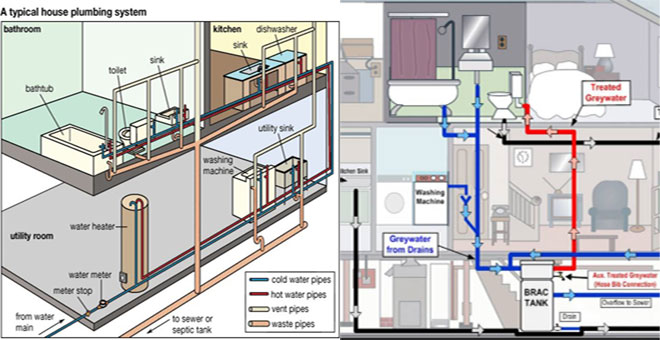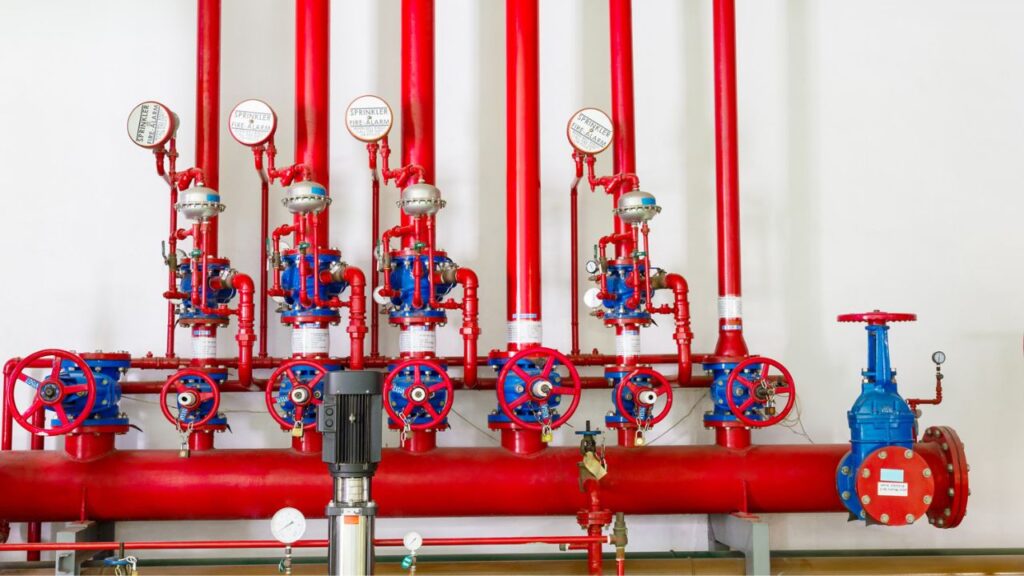Exploring The Structure of Your Home's Plumbing System
Exploring The Structure of Your Home's Plumbing System
Blog Article
The content on the next paragraphs on the subject of Exploring Your Homes Plumbing Anatomy is particularly entertaining. Give it a try and draw your own personal ideas.

Recognizing just how your home's pipes system functions is necessary for each property owner. From delivering clean water for drinking, cooking, and showering to securely getting rid of wastewater, a properly maintained pipes system is important for your household's health and convenience. In this extensive overview, we'll discover the elaborate network that makes up your home's pipes and deal ideas on maintenance, upgrades, and managing usual issues.
Intro
Your home's pipes system is more than simply a network of pipes; it's an intricate system that guarantees you have access to clean water and reliable wastewater removal. Understanding its components and just how they collaborate can aid you stop pricey fixings and make sure everything runs efficiently.
Standard Parts of a Pipes System
Pipes and Tubing
At the heart of your pipes system are the pipes and tubes that carry water throughout your home. These can be constructed from various products such as copper, PVC, or PEX, each with its advantages in regards to toughness and cost-effectiveness.
Fixtures: Sinks, Toilets, Showers, etc.
Components like sinks, bathrooms, showers, and bath tubs are where water is utilized in your home. Recognizing exactly how these fixtures attach to the pipes system helps in detecting problems and intending upgrades.
Valves and Shut-off Factors
Shutoffs control the circulation of water in your plumbing system. Shut-off shutoffs are vital during emergency situations or when you require to make repair work, permitting you to isolate parts of the system without disrupting water circulation to the entire home.
Water Supply System
Main Water Line
The main water line links your home to the municipal water system or an exclusive well. It's where water enters your home and is dispersed to different components.
Water Meter and Pressure Regulatory Authority
The water meter actions your water usage, while a stress regulator guarantees that water streams at a secure stress throughout your home's plumbing system, preventing damages to pipes and fixtures.
Cold Water vs. Warm water Lines
Understanding the difference in between cold water lines, which supply water directly from the major, and warm water lines, which carry heated water from the hot water heater, aids in repairing and planning for upgrades.
Drainage System
Drain Pipes and Traps
Drain pipes bring wastewater far from sinks, showers, and bathrooms to the sewage system or septic system. Traps prevent sewer gases from entering your home and also catch particles that can create clogs.
Ventilation Pipes
Ventilation pipes permit air right into the drainage system, preventing suction that can reduce water drainage and create traps to empty. Appropriate ventilation is necessary for keeping the integrity of your pipes system.
Importance of Proper Drain
Making certain proper drainage avoids back-ups and water damages. Regularly cleaning drains and maintaining traps can avoid costly repair work and prolong the life of your plumbing system.
Water Heating System
Kinds Of Water Heaters
Hot water heater can be tankless or typical tank-style. Tankless heating systems warm water on demand, while tanks save warmed water for immediate use.
Updating Your Pipes System
Factors for Updating
Updating to water-efficient components or replacing old pipelines can improve water quality, decrease water bills, and increase the worth of your home.
Modern Plumbing Technologies and Their Benefits
Discover technologies like clever leakage detectors, water-saving bathrooms, and energy-efficient water heaters that can conserve money and minimize environmental impact.
Price Factors To Consider and ROI
Calculate the ahead of time prices versus long-lasting cost savings when considering pipes upgrades. Lots of upgrades pay for themselves via minimized utility costs and fewer repairs.
How Water Heaters Attach to the Pipes System
Understanding exactly how water heaters connect to both the cold water supply and warm water distribution lines aids in identifying concerns like inadequate hot water or leakages.
Maintenance Tips for Water Heaters
Regularly flushing your hot water heater to eliminate debris, checking the temperature level settings, and inspecting for leaks can expand its life-span and enhance power effectiveness.
Common Pipes Issues
Leaks and Their Reasons
Leaks can take place due to maturing pipelines, loosened fittings, or high water stress. Resolving leakages promptly stops water damage and mold development.
Blockages and Blockages
Obstructions in drains and toilets are commonly triggered by purging non-flushable items or a build-up of oil and hair. Utilizing drain displays and being mindful of what decreases your drains can protect against blockages.
Indicators of Plumbing Issues to Expect
Low water stress, slow drains pipes, foul odors, or unusually high water expenses are signs of possible pipes problems that should be attended to promptly.
Pipes Upkeep Tips
Regular Assessments and Checks
Set up annual pipes evaluations to capture issues early. Search for indicators of leaks, rust, or mineral buildup in taps and showerheads.
Do It Yourself Maintenance Tasks
Basic jobs like cleaning tap aerators, checking for bathroom leakages using color tablet computers, or protecting revealed pipelines in cool environments can prevent major pipes problems.
When to Call a Specialist Plumbing Professional
Know when a plumbing issue requires professional proficiency. Attempting complicated repair services without correct understanding can cause even more damage and greater fixing costs.
Tips for Minimizing Water Usage
Simple practices like taking care of leakages promptly, taking shorter showers, and running full tons of washing and recipes can preserve water and lower your utility bills.
Eco-Friendly Plumbing Options
Consider sustainable plumbing products like bamboo for flooring, which is durable and environment-friendly, or recycled glass for counter tops.
Emergency situation Readiness
Actions to Take During a Plumbing Emergency
Know where your shut-off valves are located and exactly how to switch off the water system in case of a burst pipeline or major leak.
Relevance of Having Emergency Get In Touches With Useful
Maintain call details for regional plumbers or emergency services readily offered for quick feedback during a plumbing dilemma.
Environmental Effect and Conservation
Water-Saving Components and Devices
Installing low-flow faucets, showerheads, and commodes can considerably lower water usage without compromising performance.
DIY Emergency Situation Fixes (When Suitable).
Short-term solutions like utilizing duct tape to spot a leaking pipe or placing a container under a dripping tap can minimize damage until a specialist plumbing professional shows up.
Conclusion.
Recognizing the composition of your home's pipes system equips you to maintain it properly, saving money and time on fixings. By following regular maintenance regimens and staying notified concerning modern pipes modern technologies, you can ensure your plumbing system runs efficiently for many years ahead.
The Anatomy of Your Home s Plumbing System
Understanding the anatomy of your home s plumbing system is essential for any homeowner. It not only helps in identifying potential issues but also facilitates effective communication with professionals when repairs or upgrades are needed. Your home s plumbing system is more than just pipes and faucets; it s a complex network that ensures the efficient and hygienic flow of water in and out of your house. In this blog, we ll dissect the crucial components of your home s plumbing system. For those in Antelope Valley, Brock Plumbing is your trusted partner for all your plumbing needs, ensuring your system functions smoothly and efficiently.
Water Supply System
Main Water Line: This is where your home s plumbing system begins. The main water line connects your home to the public water supply or a private well. Pipes and Shut-off Valves: Pipes distribute water throughout your home. Shut-off valves are crucial for controlling the flow of water and making repairs without shutting off the entire system. Drainage System
Drain Pipes: These pipes carry waste and water away from sinks, toilets, and showers. Vents: Vents allow sewer gases to escape and help maintain proper pressure in the drainage pipes, ensuring efficient flow of wastewater. Traps: Every fixture has a trap, a U-shaped pipe that holds water and prevents sewer gases from entering your home. The most common is the P-trap under sinks. Fixtures and Appliances
Fixtures and appliances are the most interacted with parts of your plumbing system. They include sinks, toilets, showers, dishwashers, and washing machines. Each fixture and appliance has its own supply and drainage connection, ensuring they receive clean water and can dispose of wastewater effectively.
Water Heating System
Your water heater is a crucial component, providing hot water to various fixtures and appliances in your home. It can be tank-based or tankless, with each type having its own set of advantages and maintenance requirements. Regular maintenance is essential to ensure efficient operation and extend the lifespan of the unit.
Sump Pump
In areas prone to flooding or with high water tables, a sump pump is an essential part of the plumbing system. It s installed in the lowest part of your basement or crawlspace and pumps out water that accumulates, preventing flooding and protecting your home from water damage.
Septic System
Homes that are not connected to a municipal sewer system have a septic system and an underground wastewater treatment structure. Understanding how to maintain your septic system is crucial to prevent backups, odors, and early system failure.
Conclusion
Your home s plumbing system is a complex and essential network, ensuring the efficient and hygienic flow of water in and out of your property. Understanding its key components helps in maintaining it properly and identifying issues before they escalate into major problems. For residents in Antelope Valley, Brock Plumbing is dedicated to providing top-notch services, ensuring that every part of your plumbing system is in perfect working order. Trust our team of professionals to handle all your plumbing needs, ensuring your home remains comfortable, safe, and well-maintained.
https://brockplumbinganddrains.com/blog/the-anatomy-of-your-homes-plumbing-system/

Hopefully you enjoyed our post about Plumbing Installation 101: All You Need to Know. Thanks a lot for taking time to browse our piece of content. Liked our blog entry? Please share it. Let other people locate it. I praise you for your time. Kindly visit our website back soon.
Click Here Report this page